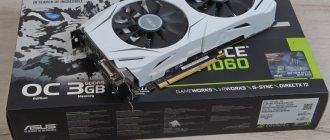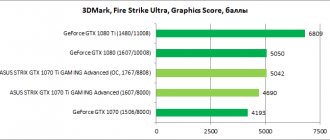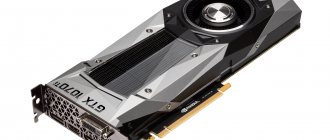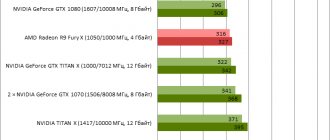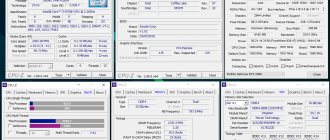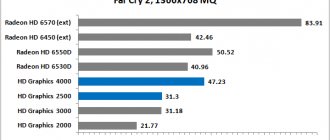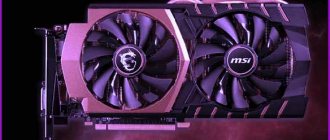After announcing the GTX 1080 and GTX 1070, presented as high-end graphics cards with the world's most "Advanced Pascal architecture", nVidia, as usual, a little later introduced budget variants of the 1060, 1050 graphics cards, as well as its new flagship 1080 Ti.
Initially, the GTX 1080, according to Nvidia itself, is 2 times more powerful than the previous generation. The GTX 1060 itself was released in conjunction with AMD's release of the mid-range Radeon RX 480 graphics card.
The GTX 1060 is approximately equal in power to the GTX 970 and twice as powerful as the 960, it all depends on the game, tasks, factory overclocking of the memory and core of the video card and its drivers, as well as optimization of programs and games that work with it..
Despite the large number of modifications from various manufacturers (ASUS, MSI, ZOTAC, GIGABYTE and others), the main characteristics of the chip will not change; only the frequency characteristics, cooling, dimensions, quality of batteries and other highly used elements of the video card will be subject to changes. And practice shows that not all people overclock; it’s easier for some to buy an already overclocked video card and not worry about overclocking. And in general, it shows that overclocking gives a performance gain of 10% - 15% (at best, if you are lucky with the device). And we should not forget that overclocking has an advantage in high-class video cards, where performance is really a little lacking, for example, at high resolutions (4k, 2k).
Official technical specifications of the GeForce GTX 1060 video card:
As can be seen from the specification, the device is initially available in two versions: a 6 GB version and a 3 GB version, the number of cores differs, but the frequencies remain the same. The only difference in memory is its volume, everything else is the same.
It should be noted that, unlike the GTX 960, which does not support virtual reality, the line of “thousandth video cards” starting from the GTX 1060 can already be used in virtual reality.
For comparison: the closest competitor of the “1060th” is the AMD Radeon RX 480 video card:
| Video adapter | GeForce GTX 1060 | Radeon RX 480 |
| Core | GP106 | Polaris 10 |
| Number of transistors | 4.4 billion pieces | 5.7 billion pieces |
| Technical process | 16 nm | 14 nm |
| Number of stream processors | 1280 | 2304 |
| Number of texture blocks | 80 | 144 |
| Number of rendering units | 48 | 32 |
| Core frequency | From 1506 Mhz to 1708 MhZ | From 1120 Mhz to 1266 Mhz |
| Memory bus | 192 bit | 256 bit |
| Memory type | GDDR5 | GDDR5 |
| Memory frequency | 8000 MHz | 8000 MHz |
| Memory capacity, MB | 6,144 GB | 8,192 GB |
| Supported DirectX Version | 12 | 12 |
| Interface | PCI-E 3.0 | PCI-E 3.0 |
| Power, W | 120 | 150 |
Manufacturers
ASUS products
Presented in 11 models: 8 six-gigabyte and 3 three-gigabyte.
All versions of GTX 1060 6Gb from ASUS
3 gig versions:
- Compact PH
- Regular Dual
- Overclocked Dual
3 Gb versions of GTX 1060 from ASUS
MSI Products
Presented by 22 models:
Gigabyte products
Gigabyte GeForce GTX 1060 5G Windforce OC
At the end of 2020, rumors appeared online about a GTX 1060 with 5 GB of video memory from Gigabyte. The rumors were confirmed by the appearance of this card on the official Chinese website of Gigabyte. The video card is overclocked from the factory to 1556 MHz in standard mode and 1771 MHz in Boost mode. There is an alternative overclocking mode, in which the frequency increases to 1582 MHz, and in boost - up to 1797 MHz.
Gigabyte GTX 1060 5G Windforce OC
The video card is dual-slot, the dimensions of the GeForce 1060 5Gb are as follows:
- length: 223 mm.
- width: 121 mm.
- thickness: 39 mm.
Connection interfaces:
- DVI-D - 2 pcs.
- HDMI 2.0b — 1 pc.
- DisplayPort 1.4 - 1 pc.
Windforce cooling is represented by a copper composite radiator and two 90 mm fans rotating towards each other. The manufacturer claims that this provides less noise and 23% better airflow compared to convection.
Zotac products
There are five available models:
Palit Company
Palit, in turn, is represented by only 8 video card models:
Inno3d company
Review of 22 GeForce GTX 1060 video cards: choosing the best model
Table of contents
- Introduction
- Nvidia GeForce GTX 1060 Founders Edition
- ASUS GeForce GTX 1060 Strix
- ASUS Dual GeForce GTX 1060 6G OC
- ASUS Expedition GeForce GTX 1060 6G OC
- ASUS Phoenix GeForce GTX 1060 6G
- EVGA GeForce GTX 1060 SC Gaming
- Gainward GeForce GTX 1060
- Gainward GeForce GTX 1060 Phoenix GS
- Gigabyte GeForce GTX 1060 G1 Gaming
- Gigabyte GeForce GTX 1060 Mini ITX OC
- Inno3D GeForce GTX 1060 Gaming OC
- Inno3D iChill GeForce GTX 1060 X3
- Inno3D GeForce GTX 1060 Compact X1
- Manli GeForce GTX 1060 Gallardo
- MSI GeForce GTX 1060 Armor
- MSI GeForce GTX 1060 Gaming X
- MSI GeForce GTX 1060 6GT OC
- MSI GeForce GTX 1060 Aero ITX 6G OC
- MSI GeForce GTX 1060 OCV1 6G
- Palit GeForce GTX 1060 StormX 6Gb
- Zotac GeForce GTX 1060 Mini
- Zotac GeForce GTX 1060 AMP! Core Edition 3Gb
- Characteristics of tested video cards
- GeForce GTX 1060 performance
- Conclusion
Introduction
The laboratory continues the series of summary materials dedicated to Nvidia graphics accelerators.
And following the review of the “baby” GeForce GTX 1050, we will look at the favorite option of gamers and sober users – the GeForce GTX 1060, including new products tested in recent months. The range of modern video cards is divided into three price segments - low, middle and upper. On the one hand, users have the right to decide, based on their beliefs and financial capabilities, which options are worth choosing. On the other hand, it is in the middle segment that the most fierce price wars flare up, since its representatives demonstrate a better price-performance ratio than flagships and provide a more comfortable gaming experience compared to budget solutions.
And it’s hard to argue with the fact that due to the lack of sane competition in the mid-price segment, the GeForce GTX 1060 video card, offered in two modifications with different amounts of memory (3 and 6 GB), is the optimal choice for gaming at a resolution of 1920 x 1080.
Earlier, in previous laboratory materials, we already summed up the results of the confrontation between Nvidia GeForce GTX 1xxx and GeForce GTX 9xx and selected the best models among the GeForce GTX 1050 Ti, GeForce GTX 1070 and GeForce GTX 1070 Ti.
announcements and advertising
2080 Super Gigabyte Gaming OC for 60 rubles.
Compeo.ru - the right comp store without any tricks
RTX 2060 becomes cheaper before the arrival of 3xxx
Ryzen 4000
series included in computers already in Citylink
The price of MSI RTX 2070 has collapsed after the announcement of RTX 3xxx
Core i9 10 series is half the price of the same 9 series
The price of memory has been halved in Regard - it’s more expensive everywhere
Nvidia GeForce GTX 1060 Founders Edition
Description on the manufacturer's website - link.
The design and appearance of Nvidia reference design video cards changes slightly; developers continue to “play” with the shapes of the casing, body breaks and the severity of the appearance. All this gives the GeForce GTX 1060 brutality and a gaming touch, which for it is the key to success.
The main task of the new product was to update the lineup and take first place in the attractiveness rating, in order to beat the main competitor in the form of the Radeon RX 480 and GeForce GTX 970, so beloved by players for their qualities. But there’s no point in comparing the tenth series with the GeForce GTX 960: the new model is 30-50% more productive.
The Founders Edition implies the presence of a certain collective image for all Nvidia video cards and is marked by a similar design and cooling system.
Under the casing there is a cooling plate for the power circuits and the main radiator. The latter is separated, and an additional section is placed on the side near the edge for beauty. Its contact with the plate is decorative, without thermal pads or paste. And there is nothing to cool on the rear side, since the power elements are located at the other end.
Considering that the new product consumes only up to 120 W, the CO is used as simple as possible. A copper plate is inserted into the base of the aluminum radiator. The fan is located at the edge and therefore it was possible to install the largest possible radiator, which is what the developers did.
The power connector cable looks sloppy. But this was done for the sake of the possibility of using the cooler of the older model, and since the new product is built on a shortened printed circuit board, such sacrifices had to be made.
An unsoldered pair of spaces for memory chips tells us about the existence of an OEM option. Perhaps Nvidia was preparing a printed circuit board for modifying some model with GP104 and 256-bit memory. If you remember, the GeForce GTX 960 also had empty spaces, but subsequently no versions were released.
The new product is equipped with a 3+1-phase power system. No highly efficient Dr.MOS technologies are used. The uPI Semiconductor Corp uP9509P PWM controller supports 4+1 power phase control. Power for the video card is provided using one 6 pin connector. In total, according to the specifications, it gives 75 W. The PCI-e connector provides up to 75 W more. As a result, 150 honest W should be enough.
The GP106 GPU is assembled on a substrate in 2020. And six Samsung memory chips with a nominal frequency of 2000 MHz are located on the front side. And since there are only six modules, it is logical to consider the width of the data exchange bus to be 192 bits.
The declared operating frequencies of the new video card are average for the Pascal generation: 1506 MHz (GPU Boost up to 1709 MHz), memory – 8000 MHz.
A quick inspection of the characteristics shows that the GeForce GTX 1060 has a base frequency like the GeForce GTX 1070, but Boost raises it to 1709 MHz, which is slightly lower than the official Boost on the GeForce GTX 1080. But in gaming applications, the younger version, on the contrary, has a higher average frequency GPUs are both GeForce GTX 1070 and GeForce GTX 1080, which is nice.
As always, our acquaintance with the new line begins with the reference video card, which my colleague Dmitry aka Rasamaha
. You can get acquainted with the material from his pen by going to the corresponding review of the Nvidia GeForce GTX 1060.
ASUS GeForce GTX 1060 Strix
Description on the manufacturer's website - link.
The ASUS video card has solid dimensions and a proprietary DirectCU III cooling system, which turn it into a real monster. You can’t help but forget about the energy-efficient 16 nm FinFET process technology and consumption of 120 W. The length of the model is an impressive 298 mm, width – 121 mm. In a PC it will cover two expansion slots.
The design of the 3D accelerator turned out to be quite interesting due to the decorative black casing and three 90 mm fans covering most of the video card. The series logos are applied to the rotors of the turntables. And the back side is covered by a “backplate” with the symbols of the Republic of Gamers. The base plate has slots in the high-elevation areas and a distinctive "X" where the GPU mounts.
The massive DirectCU III cooling system installed on top versions also found its home on the ASUS GeForce GTX 1060 Strix video card. The developers decided in this way to simplify the task of developing a new cooler, and at the same time turn the model in question into real ice.
The name DirectCU III itself, with the help of a slight play on words, is translated as “direct copper contact,” which we celebrate. The two-section radiator, made up of many nickel-plated aluminum plates, is impressive. They are threaded with five heat pipes according to the “6+8+8+8+8” scheme, all connections are expertly soldered.
The contact pad in the second section of the radiator is responsible for removing heat from the VRM zone. A gray thermal pad is used as a thermal interface. The connections are brought closer to the center, which more intelligently distributes the clamping force.
Three 90 mm fans are responsible for the active part; the impeller diameter is more modest and is about 85 mm. They are presented by Everflow, model T129215SU, characteristics 12 V and 0.50 A, and are capable of operating in the range of 0 - 3600 rpm.
ASUS engineers didn’t bother and took the finished developments of the GeForce GTX 1070 Strix model, removed the SLI connectors and a couple of memory chips at Nvidia’s request and got what they were looking for. The result is a printed circuit board that is in no way inferior to its older brothers. It is built using high-quality element base, which corresponds to the proprietary Super Alloy Power II concept.
On the back side there are two 4-pin connectors for connecting case fans, called “ASUS FanConnect”. The idea is interesting in that it allows the video card to control the turntables on the front panel of the case depending on the temperature of the graphics processor: the hotter it is, the higher the rotation speed. Another “know-how” that has the right to life.
The power subsystem is made according to the “6+1” formula, where six phases are allocated to the graphics processor and one to the video memory. Such VRM organization will be the envy of top-end video cards, and not just models with a modest TDP level of 120 W. The uP9511P microcircuit manufactured by uPI Semiconductor is used as a PWM controller.
The ASUS GeForce GTX 1060 Strix model operates at the standard frequencies of the reference version: the graphics processor frequency is 1506 MHz, it dynamically rises to 1709 MHz and higher, the video memory operates at 2000 MHz.
The developers also presented the “OC” version, and the proprietary ASUS Tweak II utility, which includes three basic profiles, also helps out. Each is designed for certain conditions - low noise, balance or high performance. The latter increases the GPU frequency to 1544 MHz.
The potential of the GP106-400-A1 video core is already known and conquering the 2 GHz threshold will not be difficult. In practice, this is what happens: the ASUS GeForce GTX 1060 Strix video card can be overclocked to 1711 MHz core, Boost – 1914 MHz, memory – 2402 MHz. In games and tests, the GPU frequency dynamically rises to 2114 MHz. The cooling system worked automatically - an excellent result.
You can find out more about the video card in the material “Review and testing of the ASUS GeForce GTX 1060 Strix video card: the owl has grown up.”
ASUS Dual GeForce GTX 1060 6G OC
Full name: ASUS Dual GeForce GTX 1060 6G OC, manufacturer code: Dual-GTX1060-O6G. Description on the company website - link.
ASUS Dual GeForce GTX 1060 6G OC impresses not only with its performance, but also with the beautiful combination of white and black colors, shimmering harmoniously against the background of the glossy coating of the CO casing.
Thanks to the original cooling system, the model does not look like a gray mouse. Its casing has many geometric kinks and slits, and the insert on top neatly masks the protruding heat pipes hidden deep in the body. Two 90mm black fans with wide blade shapes highlight the appearance.
The body of the radiator consists of 52 aluminum plates, which are penetrated by two heat pipes with a diameter of 8 mm each. The thickness of the cooler is small and the technology of direct contact with the graphics processor is used.
A tiny radiator with fins is responsible for cooling the power part. This solution will be saved from overheating by a fan located directly above the VRM area.
The uP9501P PWM controller is responsible for voltage control. The power subsystem is five-phase: four phases are allocated to the GPU, one to the video memory.
Review of ASUS Dual GeForce GTX 1060 6G OC in our laboratory.
ASUS Expedition GeForce GTX 1060 6G OC
Full name: ASUS Expedition GeForce GTX 1060 6G OC, manufacturer code: EX-GTX1060-6G. Description on the company website – link.
The appearance and design of the ASUS Expedition GeForce GTX 1060 6G OC is minimalist on the one hand, and aggressive on the other. An almost monolithic casing completely covers the cooling system, and small slots along the perimeter release hot air near the printed circuit board itself, providing maximum airflow to the elements.
Red inserts slightly transform the blacked-out appearance of the model, emphasizing the 90 mm turntables with the manufacturer’s logo.
A large radiator is hidden under the casing, covering the entire printed circuit board. Let’s not make any guesses and say that the CO is completely identical to the ASUS Dual GeForce GTX 1060 6G OC model discussed above.
The body of the cooler consists of 52 aluminum plates, penetrated by two heat pipes with a diameter of 8 mm each. The power supply circuits are covered by a separate low-profile radiator.
Review of ASUS Expedition GeForce GTX 1060 6G OC in our laboratory.
ASUS Phoenix GeForce GTX 1060 6G
Full name: ASUS Phoenix GeForce GTX 1060 6G, manufacturer code: PH-GTX1060-6G. Description on the company website – link.
In the case of the ASUS Phoenix GeForce GTX 1060, the developers used a win-win version of the racing color, but it is difficult to distinguish the new product from its peers. The rustic design does not complement the usual aluminum radiator, which peeks out alone from under the cooler casing.
However, the ASUS Phoenix GeForce GTX 1060 6G was created as a democratic solution, so it is hasty to criticize it only for its appearance, especially if the video card will be used in many inexpensive cases without a side window. The central place is given to a 90 mm fan.
At first glance, it seems that the hero of the review received a simple aluminum radiator with diverging fins. But look at the copper core, which should provide a small increase in efficiency.
Review of ASUS Phoenix GeForce GTX 1060 6G in our laboratory.
EVGA GeForce GTX 1060 SC Gaming
Description on the manufacturer's website - link.
The small box hides a tiny EVGA video card, the size of which is surprising at first. However, despite the junior status in the line, the developers treated it with the same dignity as their more expensive brothers: they packed it in a double antistatic bag, a layer with air bubbles, and equipped it with protective caps. The detail is in the details.
Externally, the EVGA GeForce GTX 1060 SC Gaming is practically unremarkable. Active cooling is provided by one 90 mm fan, which is becoming a classic in the case of compact video cards. But the length of the model has increased by 4 mm and is 174 mm, the width is 110 mm. In the system unit it will cover two expansion slots.
Cooling systems for compact video cards deserve close attention. Engineers have to develop solutions with limited dimensions and rigid boundaries. And as effective as possible: of course, if the developers do not want to cheat or save money. Let's see what surprises the EVGA GeForce GTX 1060 SC Gaming model will bring.
The radiator in this case is made in the form of a compact “single-section”, composed of 52 aluminum fins. At the rear there are characteristic through holes for hot air. On a positive note, we note that the cooling system is equipped with two heat pipes. In addition, their diameter is 10 mm, which increases the efficiency of the entire structure.
The model produced by Power Logic, marked PLA09215B12H, is responsible for the active part. It is capable of operating in the range of 1200-2600 rpm, remaining quiet until 1650 rpm.
The EVGA GeForce GTX 1060 SC Gaming video card is made on a black PCB, completely copying the Nvidia reference design. The only changes lie in the soldered additional power connector: the original model received a remote connector on wires to ensure compatibility with the GeForce GTX 1080 cooling system.
The power subsystem is made according to the “3+1” formula, where three phases are allocated to the graphics processor and one to the video memory. The uP9509P microcircuit manufactured by uPI Semiconductor is used as a PWM controller.
From my point of view, small video cards also have the right to factory overclocking. Apparently, EVGA developers think the same thing, who increased the core frequency of their model from 1506 MHz to 1607 MHz at a voltage of 1.05 V, in Boost mode - from 1709 MHz to 1835 MHz. Video memory operates at the reference 2002 MHz.
Partially its capabilities will be rehabilitated by the overclocking potential. EVGA GeForce GTX 1060 SC Gaming almost immediately conquered the core frequency of 1730 MHz and video memory of 2402 MHz, and thanks to GPU Boost in games it increased to 2126 MHz. The fan operated at a fixed 80% (2080 rpm).
You can learn more about the video card in the material “Review and testing of the EVGA GeForce GTX 1060 SC Gaming video card.”
Gainward GeForce GTX 1060
Description on the manufacturer's website - link.
The Gainward GeForce GTX 1060 video card looks simple: no bright inserts, lights or inscriptions. Perhaps it's even better this way. The company has a signature Phoenix line, but this variant is a base model released as an alternative to the reference design version.
An original cooling system with two 92 mm fans is installed. Due to the decorative plastic casing and the not very large radiator, the new product feels very light.
The Gainward GeForce GTX 1060 cooling system, despite its visual simplicity, in practice turns out to be an interesting solution for engineers. Behind the plastic casing is an all-metal structure that combines a radiator and a plate that covers all the hot elements on the board.
The passive part is presented in the form of a single-section radiator, assembled with 40 nickel-plated aluminum plates. They are pierced by three copper U-shaped heat pipes with a diameter of 6 mm each. All connections are carefully soldered.
In the VRM zone, there are two technological openings for air flows forced by fans, but one of them is blocked by the blind part of the fins in the lower section. Well, let's take a closer look at the temperature regime in the next section.
Two 92mm fans are manufactured by Power Logic. Before us are the PLD09210S12HH models, capable of operating in the range of 0-3200 rpm. They are connected to a single board under the casing and are easily replaceable.
The Gainward GeForce GTX 1060 video card is built on an original black PCB. Let us note the loose arrangement of elements, which is typical for the company’s products. Despite the apparent similarity with models of the GeForce GTX 4xx and GTX 5xx lines, the absence of an SLI connector suggests that the PCB was developed by engineers from scratch.
The new product is made using high-quality Superior Hardware Design components, which includes solid-state and tantalum-polymer capacitors. The power subsystem is made according to the “3+1” formula, where three phases are allocated to the graphics processor, one to the video memory. The fourth phase remains unsoldered and is intended for the Phoenix version.
The old familiar NCP 81174 chip manufactured by ON Semiconductor is used as a PWM controller.
The Gainward GeForce GTX 1060 model operates at the standard frequencies of the reference version. The core frequency is 1506 MHz, in Boost mode it reaches 1709 MHz, the video memory frequency is 2000 MHz.
The utilities used include support for new Nvidia video cards. However, in MSI Afterburner the voltage slider is inactive, the ASUS Tweak II utility helps out: +100 mV is available across the GPU, but this did not affect overclocking.
The final overclocking at Power Limit +116% was +200 MHz for the core and +300 MHz for the memory. In games and benchmarks, thanks to GPU Boost 3.0, the core frequency dynamically increased to 2088 MHz. With modern Nvidia graphics accelerators, many users can reach the 2 GHz mark on their own. And this is not fantasy.
You can learn more about the video card in the material “Review and testing of the Gainward GeForce GTX 1060 video card.”
Gainward GeForce GTX 1060 Phoenix GS
Full name: Gainward GeForce GTX 1060 6GB Phoenix “GS”, manufacturer code: 426018336-3736. Description on the company website – link.
The video card under study externally resembles the GeForce GTX 700 and GTX 900 series, but when developing the new line, the designers made the appearance more current. Not only the size of the package is impressive, but also the dimensions of the phoenix video card.
Gainward GeForce GTX 1060 Phoenix GS is made in a three-color design, these are shades of black, red and gold. The casing of the new product has rounded shapes, metal inserts and two large 90 mm fans with an original structure of blades that have received notches.
And its three-slot cooling system, which, to be more precise, occupies two and a half slots, turns the Gainward GeForce GTX 1060 Phoenix GS into something sturdy, reminiscent of, forgive me the editors, a small brick. But in this situation, you can expect good results, without any discounts for engineers.
Gainward is one of the divisions of Palit Microsystems, so it is not surprising that their graphics accelerators are sometimes as similar as two peas in a pod. Yes, we are talking about the Palit GeForce GTX 1060 Super JetStream version.
The entire printed circuit board is covered by a massive plate, something similar we saw on the regular version of the Gainward GeForce GTX 1060. In addition to the power transistors, it covers all the video memory chips.
The power subsystem is built according to a “3+1” scheme, in which three phases are allocated to the graphics processor, and one to video memory.
Review of Gainward GeForce GTX 1060 Phoenix GS in our laboratory.
Gigabyte GeForce GTX 1060 G1 Gaming
Description on the manufacturer's website - link.
After getting acquainted with the Gigabyte GeForce GTX 1070 and GeForce GTX 1080 models of the G1 Gaming line, you expect the younger version to have a similar design, but this expectation is only partially confirmed. On the one hand, the expressive black casing of the Windforce cooling system is emphasized by orange inserts covering the sides of the radiator.
However, instead of three fans, the Gigabyte GeForce GTX 1060 G1 Gaming video card has two, but larger diameters. These are 92 mm fans that do not completely cover the cooler area. Note that they rotate in different directions, which, according to Gigabyte developers, has a positive effect on the efficiency of the CO.
Despite its positioning, the version of the GeForce GTX 1060 in question may be on the reverse side of the circuit board. The manufacturer's name is printed on the base plate; there are no through slots for air circulation.
The massive Windforce 2X cooling system covers the entire printed circuit board, from which the Gigabyte GeForce GTX 1060 G1 Gaming protects the mount around the perimeter of the GPU and VRM area, as well as the support plate.
The base of the cooler is made in the form of an aluminum sole with two heat pipes with a diameter of 6 mm, which are in good contact with the GPU. And the expanded metal insert allows you to cool the video memory chips. Thin thermal pads, which are actually very fragile, are responsible for heat transfer.
The main element of any cooling system is the radiator. On the Gigabyte GeForce video card, its role is played by a two-section cooler made up of many plates. All connections are carefully soldered. The second section removes heat from the power subsystem using a soldered sole and a thick thermal pad.
Two turntables produced by Power Logic, marked PLD09210S12HH, are responsible for the active part. Their diameter is 92 mm, the impellers themselves are slightly more modest - 87 mm. Models operate in the range 0 – 2950 rpm at 12 V and 0.40 A.
The version of the GeForce GTX 1060 under review differs from the reference sample in the use of a non-reference printed circuit board with a glossy finish. The developers took the PCB of the GeForce GTX 1080 G1 Gaming model as a basis, with the only difference being that the new product lacks several power phases and two SLI connectors.
The high-quality element base is made according to the Ultra Durable VGA concept, which includes the use of high-quality capacitors, chokes with ferrite cores and field-effect transistors.
The power subsystem is made according to the “6+1” formula, where six phases are allocated to the graphics processor and one to the video memory, which distinguishes it better from the reference model with a four-phase power system. The uP9511P microcircuit manufactured by uPI Semiconductor is used as a PWM controller.
Video cards of the original design are mostly factory overclocked, and the Gigabyte GeForce GTX 1060 G1 Gaming model is no exception. The core clock frequency has been increased from 1506 MHz to 1595 MHz; in Boost mode it increases from 1709 MHz to 1810 MHz. Video memory operates at the reference 2000 MHz.
Using the Xtreme Gaming Engine utility, the Gigabyte GeForce GTX 1060 G1 Gaming video card was able to operate stably at core and memory frequencies of 1750 MHz and 2402 MHz, respectively. In games and benchmarks, the GPU frequency dynamically rose to 2139 MHz, without sagging under high load. It is worth noting that in this case the fan speed was set to 100% (2880 rpm).
You can learn more about the video card in the material “Review and testing of the Gigabyte GeForce GTX 1060 G1 Gaming video card.”
Gigabyte GeForce GTX 1060 Mini ITX OC
Description on the manufacturer's website - link.
As is clear from the name, the Gigabyte GeForce GTX 1060 Mini ITX OC 3G is made within the ITX form factor, that is, its length does not exceed 170 mm. The entire front side of the board is covered with a massive cooling system, as far as possible for ITX.
The set of video outputs is non-standard: on the rear panel there are single DisplayPort 1.4 and HDMI connectors, as well as a pair of Dual-Link DVI-D.
The dual-slot cooler used includes two composite copper heat pipes that are in direct contact with the GPU, a dense array of aluminum plates and a 90 mm axial fan with textured blades.
When the video card core is at minimum load, the fan is silent and starts only when a certain temperature is reached. This is the Power Logic model PLD09210S12HH with an impeller diameter of 90 mm.
The Gigabyte GeForce GTX 1060 Mini ITX OC video card is built on a black printed circuit board. Its dimensions are comparable to motherboards of the mini-ITX form factor, so dense installation of hinged elements is used, especially for the rear part. There are no similarities with the PCB of other models.
The element base corresponds to the Ultra Durable VGA concept and is made up exclusively of high-quality components: Japanese solid-state capacitors, chokes with ferrite cores and field-effect transistors.
The power subsystem is built according to a “3+1” scheme, where three phases are allocated to the graphics processor and one to the video memory. All this is controlled by the familiar NCP81174 PWM controller, which supports voltage regulation on the GPU.
For the Gigabyte GeForce GTX 1060 Mini ITX OC version, the developers slightly increased the clock speeds, so we can talk about factory overclocking. True, it is not that significant: the core frequency is 1531 MHz versus the reference 1505 MHz, the video memory frequency is unchanged and equals 2002 MHz.
Small, but smart. In this experiment, the Gigabyte GeForce GTX 1060 Mini ITX OC model almost overtakes its older brothers, because the core frequency bar was raised to 1721 MHz, video memory - to 2365 MHz. In Boost mode, the GPU operated at 2000 MHz.
More details about the video card can be found in the material “Review and testing of the Gigabyte GeForce GTX 1060 Mini ITX OC 3G video card.”
Inno3D GeForce GTX 1060 Gaming OC
Description on the manufacturer's website - link.
The Inno3D GeForce GTX 1060 Gaming OC model stands out for its interesting appearance of the cooling system. The plastic casing has transparent red inserts, and two large fans are moved closer to the front of the video card. Once again, you are surprised by the design approaches to the younger Inno3D models: developers never stop experimenting with budget graphics accelerators.
The reverse side of the Inno3D version is covered with a pressure plate, which is a big plus. In my opinion, a “backplate” should be present on any large video card with a massive cooling system, protecting it from excessive bending under its own weight.
The Inno3D GeForce GTX 1060 Gaming OC cooling system is a single design. The radiator is evenly “permeated” with four heat pipes, which should ensure uniform heat distribution. In addition, the heat dissipator fins not only dissipate the heat transferred by the heat pipes, but also received contact with the base of the cooler, both in the GPU area and in the power converter area.
Among the positive qualities of the cooling system, we note that it removes heat from all heating elements of the printed circuit board: from the graphics processor, and from memory chips, and from power converters.
The fans used are Colorful CF-121015S, impeller diameter is 95 mm.
The printed circuit board is a copy of the GeForce GTX 1080 reference design. But in this case, unsoldered elements are clearly visible, in addition to seats for two memory chips. This is one additional phase of the GPU power supply, and half of the transistors of the GPU and memory power converters.
However, the reference version of the GeForce GTX 1080 is the same. And if there may be a lack of video card capabilities to realize the potential of the graphics processor, then in the case of the GP106 video core, the “margin of safety” is significant.
The GPU power converter is five-phase, the memory power converter is single-phase. In the first case, an eight-phase uP9511P manufactured by uPI Semiconductor, located on the reverse side of the printed circuit board, was used as a PWM controller.
As the name already implies, the Inno3D video card is overclocked from the factory and runs at GPU frequencies of 1569/1785 MHz. Let us remind you that the standard frequencies for the GeForce GTX 1060 are 1506/1709 MHz.
Thanks to the use of a printed circuit board of an older model and a reinforced power subsystem, an effective cooling system and a successful sample, the Inno3D GeForce GTX 1060 Gaming OC was able to overclock the core and memory to 1749 MHz and 2347 MHz, respectively.
You can learn more about the video card in the material “Review and testing of the Inno3D GeForce GTX 1060 Gaming OC video card.”
Inno3D iChill GeForce GTX 1060 X3
Description on the manufacturer's website - link.
After taking the Inno3D video card out of the box, due to its enormous size, you perceive it as just another monster from the future. Of course, this is not the largest model we have seen, but there is not the slightest reminder of its former fragility.
However, the company’s developers never set themselves the task of releasing a compact version, so the dimensions of the Inno3D iChill GeForce GTX 1060 X3 along with the standard HerculeZ cooling system are predictable. It was distinguished by a massive CO with three 90 mm fans, partially hidden by a metal casing. Note that the design of the iChill line is becoming more and more detailed every year.
The length of the video card is 303 mm, width – 111 mm, in a PC it will cover two and a half expansion slots. A real monolith that looks confident in a gaming system.
The cooler is a two-section radiator, assembled with nickel-plated aluminum plates with a total of 123 pieces: it would be a complete horror to count them manually, since the exact figure is given on the official portal. The fins are pierced by five heat pipes: two outer ones with a diameter of 8 mm and three central ones with a diameter of 6 mm. All connections are carefully soldered.
The HerculeZ cooling system is built using three fans with a diameter of 90 mm, the impeller diameter is 86 mm. Before us is the CF-12915S Colorful model. Its characteristics are 12 V and 0.35 A. And for video memory chips there is a separate plate with black thermal pads.
As with the GeForce GTX 1060 Gaming OC, the GeForce GTX 1080 reference design PCB is used. And don’t be afraid of a bunch of unsoldered elements, because this also migrated from the older model.
And taking into account the fact that the appetites of the GeForce GTX 1060 are somewhat lower, problems should not arise. If you put the GeForce GTX 1080 next to it, then in addition to the SLI connector and a couple of additional memory chips, you will have to look for other differences with a magnifying glass.
The GPU power converter is five-phase, the memory power converter is single-phase. The eight-phase uP9511P manufactured by uPI Semiconductor, located on the reverse side of the board, is used as a PWM controller in the GPU power converter.
The Inno3D iChill GeForce GTX 1060 X3 video card is equipped with a slight factory overclock - the core frequency is increased from 1506 MHz to 1569 MHz (in Boost mode - up to 1785 MHz), the video memory operates at an increased value of 2052 MHz.
When overclocking, it is possible to increase the core frequency to 1730 MHz (Boost - up to 1946 MHz), memory - 2360 MHz.
You can learn more about the video card in the material “Review and testing of the Inno3D iChill GeForce GTX 1060 X3 video card: P-show-off.”
Testing the GTX 1060 video card
Since the video card is of a middle class and does not pretend to have resolutions greater than FullHD (1920×1080), we will test all games in this resolution.
Let's take the latest games, which can really show the load on the video card. Let us remind you that The Witcher 3 was released in 2020, but even nVidia’s flagship could very hardly show the cherished and beloved “Sixty frames per second”. Yes, the new generation is already running smoothly (with the possible exception of the 1050), unlike the Maxwell generation (900 series).
| GeForce GTX 960 | GTX 1050 | GTX 1060 | Radeon R480 | |
| Battlefield 1 | 30 | 30 | 74 | 53 |
| Call of Duty: Infinite Warfare | 44 | 48 | 59,6 | 72 |
| The Witcher 3: Wild Hunt | 26,8 | 22,6 | 40,4 | 53 |
| Watch Dogs 2 | 30,8 | 32,9 | 51,4 | 41 |
In general, tests show that compared to the GeForce GTX 960, the tenth series of the sixty is 30-50% more productive.
Benchmark comparison
GPU 1: NVIDIA GeForce GTX 1650 Ti GPU 2: NVIDIA GeForce GTX 1060 6 GB
| Geekbench - OpenCL | GPU 1 |
| GPU 2 |
| 35629 |
| GPU 2 |
| 767 |
| GPU 2 |
| 10249 |
| GPU 2 |
| 4166 |
| Name | NVIDIA GeForce GTX 1650 Ti | NVIDIA GeForce GTX 1060 6 GB |
| Geekbench - OpenCL | 42578 | 35629 |
| PassMark - G2D Mark | 420 | 767 |
| PassMark - G3D Mark | 7720 | 10249 |
| 3DMark Fire Strike - Graphics Score | 3680 | 4166 |
| CompuBench 1.5 Desktop - Face Detection (mPixels/s) | 119.051 | |
| CompuBench 1.5 Desktop - Ocean Surface Simulation (Frames/s) | 1376.407 | |
| CompuBench 1.5 Desktop - T-Rex (Frames/s) | 8.694 | |
| CompuBench 1.5 Desktop - Video Composition (Frames/s) | 21.452 | |
| CompuBench 1.5 Desktop - Bitcoin Mining (mHash/s) | 456.147 | |
| GFXBench 4.0 - Car Chase Offscreen (Frames) | 12442 | |
| GFXBench 4.0 - Manhattan (Frames) | 3691 | |
| GFXBench 4.0 - T-Rex (Frames) | 3340 | |
| GFXBench 4.0 - Car Chase Offscreen (Fps) | 12442 | |
| GFXBench 4.0 - Manhattan (Fps) | 3691 | |
| GFXBench 4.0 - T-Rex (Fps) | 3340 |
Which processor will open 1060
Any 4-core processor with a frequency of 3.5 Mhz is quite sufficient for this video card, the more the better. In theory, a Core i3 may be enough, but it is still recommended to take, for example, a Core i5 6400 (Skylake), and in principle, the Haswell generation will be able to perform well.
If we talk about exceptions, then, for example, GTA V may not fully load the video card, since it largely uses the processor for physics. For this video card, the frequency is more important, so it is better to overclock the same 6400 on the bus.
GTX 1060 reduced power consumption
Reducing energy consumption is a very important thing, especially if it is in a certain region. Where you plan to mine, electricity is expensive. Reducing power consumption is done in addition to overclocking. Don't be afraid of a decrease in hashrate. It decreases slightly, but electricity consumption is several times less. Thus, by setting the Power Limit to approximately 70%, the hashrate will decrease by only 0.3 megahashes per second. The card will still show a good result at about 24 megahashes, but the energy consumption in this case will decrease to 80 watts.
At the same time, you need to make sure that the memory frequencies remain overclocked and unchanged. Regardless of the region in which mining of a particular crypt will take place, reducing energy consumption is a reasonable and profitable step. But that is not all. Likewise, GPU heating is reduced. Setting the Power Limit to 70% will result in a temperature of 58 degrees Celsius. This way you will avoid overheating and burning out of the video card, therefore you will not have to change equipment, and there will be no additional costs.
Correct overclocking of GTX 1060 on Ethereum
Correctly overclocking a video card using Afterburner software or something similar will increase your profits by at least 20-25%. Under no circumstances should there be Hynix video memory on the GPU, in which case profits will drop by about a fifth. If you come across just such a card, then mining Ethereum and similar cryptocurrencies is not the best idea. But it copes with the mining of Zek, Hash and other similar cryptocurrencies. All this can be checked using Gpu-z. This is required software. The best video memory for Ethereum mining is made by Samsung or Micron Corporation.
The next must-have Ethereum mining program is the aforementioned MSI Afterburner. This is extremely simple and understandable software, and therefore the most popular. After launching Afterburner, you need to check all the boxes in the “Basic Properties” section and do the same in the “Compatibility Properties” section, but do not check the box next to “Force constant voltage”. These settings will also apply to other video cards. It happens that identical cards overclock differently. Sometimes it depends on a bad power supply, and sometimes on other factors.
So, the Ethereum coin works on the Ethash algorithm (DaggerHashimoto). Other cryptocurrencies also operate on this algorithm. The bottom line is that for all of them it is necessary to overclock the video memory, and leave the core at zero. You need to start with +300, and then gradually add +50.
The point is that when installing a new GPU, you can even immediately set +500. After this, you need to immediately see if there are crashes or any problems. If everything is good, then you can add until broken balls, flyouts and other problems appear. As soon as they arise, you need to return to the value at which everything worked stably.
To consume a minimum of electricity and avoid overheating of the video card, you must set Power Limit. For a six-gigabyte GTX 1060 it is 65%. The slider should be slowly lowered until the hashrate begins to decrease. Then we need to return everything to the situation when megahashes were stable.
After all the work done, it becomes clear that the power increases to 23-24 megahashes. If video memory from Samsung is installed, then you can achieve better results. At +800 the power exceeds 24 megahash.
Gigabyte GeForce GTX 1060 6GB mining performance overclocked
Depending on what crypt and how to mine on 1060, you can achieve different results. Ethereum mining on Claymores consumes 75 watts of electricity with a hashrate of 23.5 megahash per second. In this case, the frequencies are +110 MHz/+920 MHz, and the Power Limit should be set to 65%.
But Ethereum mining on Nvidia Optimized Ethminer boasts 25 megahashes per second. Power Limit remains the same, but power consumption increases to 80 watts. Frequencies are +100 MHz/+935 MHz.
If you mine Ethereum and at the same time mine Decred on Claymores, this will not greatly affect the production of ether. At frequencies of +110 MHz/+920 MHz, Ethereum will be mined with a power of 22.7 megahashes, and Decred - 227.5 megahashes. Power Limit is set to 80% and power consumption is 95 watts.
Simultaneous mining of Ethereum and Siacoin on Claymores at frequencies of +110 MHz/+920 MHz and Power Limit set to 80%, power consumption will be 95 watts - this is a bit much . But Ether will be mined with a hashrate of 22.7 megahash per second, and Siacoin - 227.5 megahash per second.
Mining on this Zcash video card without overclocking and changing the Power Limit settings on EWBFs requires 130 watts of electricity. At the same time, the hash rate is 295 Sol per second. If you mine the same currency overclocked with the Power Limit slider changed to 85% on EWBFs, then the power consumption will be 100 watts. At frequencies of +107 MHz/+926 MHz, the hashrate reaches 320 sol per second.
Mining on GTX 1060 NiceHash:
- Neo Scrypt on experimental – 0.413 megahashes per second (approximately 0.0003 bitcoins per day).
- Lyra2Rev2 per sminer – 21.3 MHS/sec (~0.0005 bitcoin per day).
- Dagger on ethminer – 21.45 MHS/sec (~0.0007 bitcoins per day).
- Decred on smine – 1.65 GHS/sec (~0.0005 bitcoin per day).
- LBRY per sminer – 0.18 GHS/sec (about 0.00063 bitcoins per day).
- Equihash on excavator – 280 Sol/sec (~0.0006 bitcoin per day).
- Pascal on excavator – 0.615 GHS/sec (~0.0002 bits per day).
- X11 Ghost ccminer – 4.890 MHS/sec (approximately 0.0003 bitcoin per day).
- X11 Ghost on Alexis sminer – 8.19 MHS/sec (~0.0005 Bitcoin per day).
Monthly profitability of mining rig: 6x GeForce GTX 1060 6GB
If we take simultaneous mining of Ethereum and Decred, then the amount of electricity needed for the rig is 650 watts. It's better to immediately buy a better power supply. For Ethereum, the hashrate reaches 136 megahashes, and for Decred – 1365 megahashes. You will have to spend about $50 a month on electricity, and the profitability, taking into account all expenses, will be a little more than $250.
Simultaneous mining of Ethereum and Siacoin:
- Ethereum hashrate is 136 megahashes per second.
- Decred hashrate is 1365 megahashes per second.
- If six GeForce GTX 1060 6GB cards are used, then mining requires about 650 watts of electricity. The ideal option is a power supply of 800-1000 watts.
- The cost of electricity is approximately $50 per month.
- The profitability, taking into account the power consumption of the video card, is about $260.
Mining Zcash:
- Zcash hashrate reaches 1920 Sol.
- When using six Nvidia 1060s, mining will require 700 watts of electricity. It is best to take a power supply for a mining rig at 850-1000 watts.
- Electricity will cost approximately $46 per month.
- On a GTX 1060, such mining, taking into account electricity costs, will bring a profit of about $300.
If you choose cash for Zcash, then to mine Zcash it is not necessary to take a six gigabyte video card. Mining on 1060 3gb is possible, such a video card performs well in this matter. On stock settings this GPU using the EWBFs Zcash Miner produces around 300 sol per second. The reality is that even if you buy GPUs at a price of more than 20 thousand rubles in order to mine ether, the entire investment will pay off only after nine months. Therefore, it is better to mine two crypts at once or focus on something else. This takes into account the cost of electricity, which is about $0.1 per kilowatt, but does not take into account the cost of other equipment. But you also need to buy a motherboard, a processor, a good power supply for the mining rig and other components.
A lot also depends on what kind of video memory is installed in the video card. Some options are simply not practical to use for mining the same ether. Experience and tests have repeatedly shown that video memory from Samsung shows the highest hashrate, while GPUs with Hynic memory are noticeably inferior in power. If you wisely reduce the power consumption of the video card, it will easily cope with the load, and there will be no problems with the temperature at all. The cards can work with the fans turned off, and there will be no need for additional cooling. It turns out that by making the correct 1060 settings for mining, you can achieve good profitability. Video cards can be used and in the right hands they will bring huge profits.

